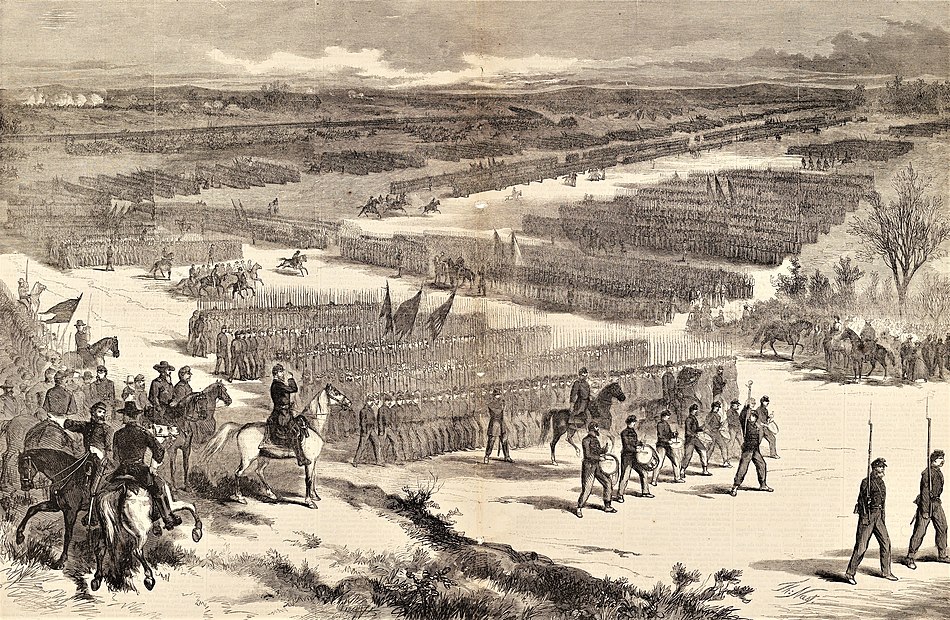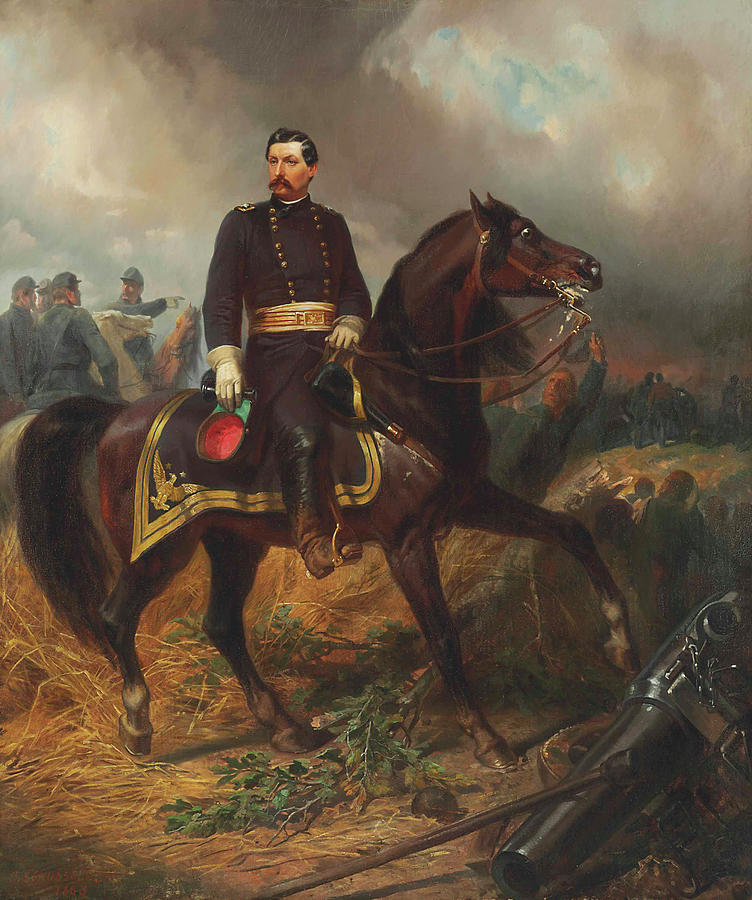American by spilled blood

The second year of American civil conflict saw New York come to provide as many as 500,000 out of a population of two million motivated largely by the Confederate advance and the loss of Washington to Lee. Due to the campaign that subdued the Great Lakes States, it made it necessary for New York to play a crucial role in supporting the war effort through materiel, weapons, ammunition, supplies and accoutrements while the Brooklyn Navy Yard became a major asset in shipbuilding and ship maintenance. In general, New York, the most populous city in the United States, was a bustling city that provided a major source of troops, supplies, and equipment for the Union Army. Powerful city politicians and newspaper publishers helped shape public opinion toward the war effort and President Lincoln's policies. The port of New York served as a fertile recruiting ground for the army, as immigrants from Europe (mainly English, Irish and German) sometimes stepped off ocean transports and were automatically recruited by recruiting sergeants. President Lincoln would even go so far as to grant US citizenship to any foreigner who is injured during a battle for the Union, this edict would be known as "American by spilled blood".

The Battle of Washington was soon followed by the Offensive on Baltimore. In view of the military disaster that Washington represented, Lincoln had the tactics changed, fighting defensively in the east, while they tried to defeat the Army of Kentucky quickly attacking. However, while the Confederation was victorious on land, the Naga Plan was applied at sea. That it had as objective to cut the maritime trade, between the Confederation and other countries that depended on the southern Cotton. The plan was a variation of the plan that Spain had made ten years before but had partial effect as the Southerners were forced to sell the cotton in New Orleans. However, both sides could see both victory and defeat getting closer. In Baltimore, the Unionists' decision to defend meant that they had taken the time to devise countermeasures. As such, when the attack was finally launched, it immediately got stuck. The strong defenses of the so-called Fortress Baltimore proved too much for Lee's forces, which responded by retreating, pursued by an army led by Brigadier General Ulysses S. Grant, who was supported by well-trained forces armed not only with rifled artillery, but also with better fed and moralized. Grant pursued Lee until catching up with him in Manassas where they clashed. Ironically, the idea of a single decisive battle was shared, between Lee and Grant. The long and complex campaign had been both a consolidation scheme and an attempt to bring the enemy into a full-scale engagement. Lee had the idea of defeating the Unionist army in the vicinity of the capital, which now lay in ruins and looted, as a way of dealing a crushing blow to northern morale. While Grant thought that winning at Manassas would inflict a terrible blow to Rebel pride and military capability.

The Battle of Manassas would be a magnificent example of military action that followed the prearranged plan: Grant organized his army's assault in four waves, causing the area around Manassas to be alight with tremendous artillery and musketry combat. Rarely has it been possible to witness such a level of ferocity and devastation, where every farm was a fort and every prairie a killing field. There were epic battles, desperate and brutal fights, but each one was overshadowed and forgotten by the next. The terrain also made progress slow. Artillery barrage had hit the ground, and a series of storms turned the area into a stretch of muddy, swampy lakes. Several thousand soldiers from both sides perished in these deplorable conditions, drowned in the mud or slaughtered by enemy forces when they became trapped in the mud. The air in some areas was thick with smoke from fired gunpowder, which further overloaded the infantry, firing at forces within a thirty-meter radius almost by surprise. By the eighth hour, the fierce Confederate resistance began to abate. Against all odds, Grant had managed to regroup the scattered forces to launch a tremendous attack against Grant's command point located on Bald Hill. The fighting was so fierce that it is not known if Grant himself had a clear idea of what was going on. He certainly was in the middle of combat, so it's hard to imagine how he would have had the ability or communications to have an overall command perspective. It is believed that Grant was basing his field orders more on intuition than data. Grant had always been a commander who trusted his own judgment and his instincts, often in the face of conflicting information, but he had established his credentials in a way that forced him to be taken seriously.

It is likely that Grant was eagerly searching for Lee, driven by a desire to take down his nemesis. It is also possible that Lee, who surely had already realized that the battle was lost and that he had no visible way to escape, wanted to have a chance to die taking the commander of the enemy army with him. In any case, Grant and Lee engaged in single combat of such intensity that the soldiers present at the scene decided to move away and even stopped fighting. The confrontation lasted between five and ten minutes, according to different witnesses, and Grant suffered two injuries, which he somehow managed to overcome to continue attacking until Lee was injured. The Virginian Lee fell back dying and the Confederates resumed fighting in an attempt to bring him to safety. The "Yankees" (term applied to the common troops of the Union) counterattacked killing many Rednecks (nickname referring to the common troops of the Confederacy). who had surrounded Grant to the point that they inflicted serious injuries on him during the attempt to take Lee away. The survivors of Grant's escort were unable to prevent Lee from escaping and ultimately ended up letting Lee escape while Grant was taken to the infirmary. Grant survived to see victory in Washington assured, though sporadic fighting and skirmishing, not to mention the aftermath, continued for quite some time.
After all the fighting, while the Yankee forces were consolidating around the capital, the state left by the southerners was exposed. The White Palace, renamed White House after the end of the Monarchy to give it a more republican feel, had been burned along with countless works of art that were left behind during Lincoln's retreat. Besides, the survivors gave disgusting testimonies of abuses that the Confederates had carried out among the population, simply for fun. Many of the survivors suffered from mental disorders and even went mad after seeing it, while in others it provoked a relentless obsession to kill those who wear the gray uniform of the Confederacy. Apart from the forces that fled after Manassas, many other forces en route to reinforce Lee's troops diverted or withdrew upon receiving news of Lee's disastrous defeat. Nearby populations suffered terribly, as they would be looted or destroyed. Almost all of those towns were on the escape route of the Confederate forces, they would be burned down by the columns of retreating troops. While Grant was removed to New York to recover from his injuries. It was decided to name a veteran William Thomas Sherman as Grant's successor. A comparative study between the goals that both Generals proposed is very illustrative regarding the differences that existed between Grant and his successor. Grant had made eliminating the enemy armies his main goal. They were unique and crucial groups of troops, since once eliminated they would consolidate the advance of the federal forces. It can be said then that Grant chose an ambitious goal and that he underestimated the effort and time it would take to achieve it, although in the end he made his decision count through hard work, determination and his refusal to change the plan.

In contrast, Sherman's objective was not to fight armies, but to conquer vital territories that, moreover, were at a considerable distance from the current front. To reach the target area, the Yankee armies would have to conquer a large part of the Confederacy, reaching the well-defended Atlanta complex. By declaring Georgia and Atlanta his target, Sherman was committing the forces under his command to an undertaking of such magnitude that Grant's ambition to defeat Lee seemed almost modest by comparison. In fact, such a plan brought him criticism from his detractors, who considered the task impossible in the short term. The scale of his ambition was considered by all to be completely laughable. Along with the dissensions among the high command officers came the news that large detachments of the archenemy were out of control after the victory against Lee. Aside from the forces that had managed to flee, there were the units that were heading there to reinforce the Archon and that had diverted or withdrawn upon learning of the defeat. The territories around Maryland were teeming with enemy forces hiding or repositioning along new lines. Many towns and forts in the region were looted or destroyed in the frenzy to regroup. Sherman was heavily criticized for failing to consolidate the positions behind Manassas. It was said that he should have mobilized several regiments to hunt down and eliminate the fugitives before they reorganized. It was said that he could have saved hundreds of people. However, it is clear that his main objective was to do so. He just didn't do it the way Grant would have done it. He did not order a gradual county-by-county consolidation coupled with a steady pursuit of the routing enemy forces before advancing from a stable base against the next enemy line.

Sherman knew that Grant had put the enemy to flight, and he wanted to take advantage of that weakness by a bold method, rather than whittling away at the armies. Georgia, replete with heavy industry and agriculture, would be a gigantic victory, and Sherman wanted to go on the offensive before the archenemy gained the upper hand by regrouping there. Sherman also knew that the southern forces lacked centralized authority and command with the situation. What he wanted was to carry out a devastating attack into the heart of the enemy by carrying out an organized maneuver that none of the scattered enemy forces could guess or react against quickly enough. In short, Sherman did not want to spend time and resources wiping out the scattered and disorganized components of the enemy force, but rather to attack its core. No one, not Lincoln, not even Grant's colonels and companions, was expected to lead the so-called Army of the Potomac across the coast to Atlanta. By the summer of 1862 the Army of Potomac began the broad advance, invading and liberating occupied territories by units the size of battalions, regiments, and even brigades of the military force of the Confederate States of America. Richmond was one of the first Confederate cities to be attacked under Sherman's command. It was a city of considerable importance, vital to the flow of supplies as it was a vital source of arms and supplies for the war effort, as well as the terminus for five railways. Sherman's plan to conquer the city was splendid even when facing veterans and Lee himself, seeing the disastrous situation, Lee decided to withdraw while they set fire to the bridges, the armory and the supply warehouses when they left. The fire in the city spread out of control and much of Richmond was destroyed until three days later, Sherman entered the city before issuing the "Scorched Earth" Order, freeing his soldiers for the widespread destruction of supplies. civilians, buildings and structures, sometimes linked to looting actions.

Another early success was Lynchburg. Sherman handed over command to Major General Joseph Hooker, who scored a quick victory within a week where, drawing on his increased training and motivation, they defeated the Confederate forces in the streets of Lynchburg. The capture of Lynchburg meant the loss of a transportation hub and supply depot for the Confederacy. The keyword for Sherman was mobility. Units deployed quickly to each objective, then moved to the next as soon as the first was under the control of second echelon troops. This process allowed the most effective and veteran units on the battlefield to move rapidly from one field to the next while keeping their combat capabilities up to date. Most of this vigorous part of the advance in the first four months were liberation battles where West Virginia was ultimately liberated. The Federal advance forced Joseph E. Johnston to abandon his operations in the Great Lakes area as he laid waste to his cities, he regrouped his forces in Louisville. Johnston's withdrawal gave time for Major General George Benjamin McClellan in command of the so-called Army of the Mississippi to advance in pursuit of Johnston who was forced to move the theater of operations to the south of the Ohio River, entering Kentucky. McClellan's forces seemed to collapse at first under the attack, but this was nothing more than a ruse to draw in the Confederate troops. To later be flanked, surrounded and methodically destroyed by a combination of tactics reminiscent of the Napoleonics: This earned McClellan the nickname of The Young Napoleon who received much publicity along with Sherman. The retreating Johnston was forced to take refuge in Lexington, Kentucky where completely surrounded, he called for help in several desperate messages sent by blockade jumpers.

However, McClellan decided that his troops would storm the city in an eight-hour battle where McClellan would say in a letter to Lincoln: "The heart of Kentucky is with the South in this fight." Abraham was forced to order McClellan whether it was necessary to burn the city, which he did in a four-hour bombardment that decimated all Confederate units to the point that the Confederates abandoned the city in the middle of the night while destroyed the city's military supplies, denying them to the Union. The fighting did not end there. Emboldened by that victory, McClellan ordered his cavalry to pursue the retreating units. The battle was fought in the middle of the night but the retreating Confederates had John Hunt Morgan in their rear who decided to hold his position to buy the southerners time to withdraw. Morgan eventually entrenched himself in a battle that saw five hundred Confederate soldiers hold off McClellan's cavalry for twelve hours. The battle, however, would be romanticized because Morgan's men more than fulfilled their mission and gave an example of what a moral and well-trained infantry is capable of doing even against forces far superior in number.
Sherman's advance saw at first spectacular success. By the end of 1862, Federal forces controlled Virginia and Kentucky and were entering North Carolina and Tennessee. Lincoln was elated by the news. For the first time since the start of the War there was a palpable sense that total victory could be achieved and that the South would cease to be the slave-owning beast that it was. Sherman's recklessness seemed justified, and his tactical ability was amply demonstrated. He finally had, apparently, the confidence of the Commanders and Generals. Sherman pressed forward with renewed fury and would even go so far as to declare that Atlanta would be in flames by the winter of the 63rd. It was a boast that would come true but would face some unintended consequences.
